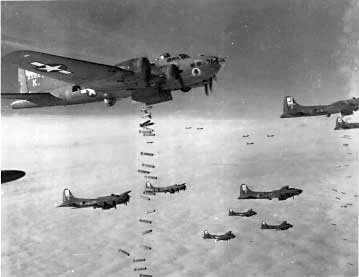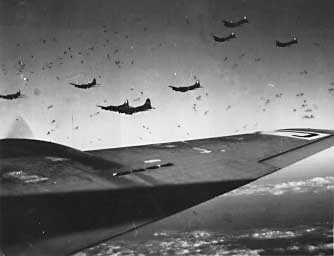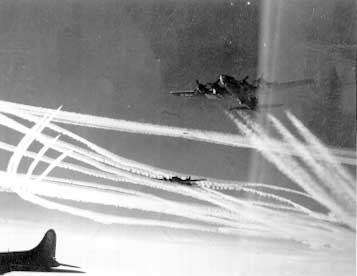![]() On July 29, however, his plane was shot down over Germany and he was reported "Missing in Action". Later through an intercepted German propaganda broadcast it was learned he was "safe and sound" and interred in a German Prison Camp, Stalag Luft III and later Stalag Luft I. He remained a prisoner for more than a year and was returned to England July 17, 1945. While in Germany he wrote daily in his diary which is now a family keepsake.
On July 29, however, his plane was shot down over Germany and he was reported "Missing in Action". Later through an intercepted German propaganda broadcast it was learned he was "safe and sound" and interred in a German Prison Camp, Stalag Luft III and later Stalag Luft I. He remained a prisoner for more than a year and was returned to England July 17, 1945. While in Germany he wrote daily in his diary which is now a family keepsake.



July 29, 1944 - Shot down – I mile NE of Niedertreba (near Jena, Germany). Imprisoned in Fr-Bel. Prison Camp at Bad Sulza (near Naumburg, Germany).
July 30, 1944 - Transferred to Prison at Weimar
July 31, 1944 - Transferred to Interrogation Camp at Oberursel
August 1, 1944 - Transferred to Transient Camp at Oberursel
August 2, 1944 - Transferred to Transient Camp at Wetzlar. Wrote card home.
August 4, 1944 - Left Wetzlar
August 4–8, 1944 - Traveled on train to Barth
August 8, 1944 - Arrived Barth. Lived in North Compound in tent.
Continue with Diary of Norman in Stalag Luft 1
The following was from Robert Hanrahan's memoirs. He was captured the same day as Norman Quast and help Norm by pulling him on a small cart. Norm sustained an injury to his knee after being trampled by a farmers horse, for which he was awarded the Purple Heart. Robert's son contacted me in early 2001 with this story. One of the wonders of the internet is how it brings people together after all these years.
…The voices came near me and someone shouted at me to get up. Sitting up, I turned around and saw three or four old men, evidently members of the Landwacht (home guard), one with a pistol, the others with rifles; three young boys were also there, one with a hatchet and one with a pitchfork. All of them were civilians.
After searching me for arms, of which I had none (as ordered by group intelligence), the old man with a Nazi swastika band on his left arm inquired, “Deutsche, Englische, Americaner?”, To which I replied proudly, “Americaner!” Using signs and the word “vas,” I asked him his nationality, to which he replied, “Polischer.” I thought possibly that all was not lost yet, but should have known better.
They marched me into the little village of Niedertrebra, the old man proudly displaying me to a chance meeting of any of his fellow townsmen. The boys looked at me more or less in awe, and they carried all my possessions into town for me: my ‘chute, flying helmet and oxygen mask, and the ‘chute harness. The old man forced me to keep my hands up all the while.
As we reached the main street of the village, I could see what looked to be the whole populace out to greet me! By this time had begun to “sweat out” my fate. About the only reception I had been given up to now was a scowl and the word “swine” in deep guttural German. Evidently, the German populace didn't go for the glowing personality of American terror fleigers.
Coming towards me down the center of the road, running at top speed, was a woman about 30 years of age with a little girl about four years old, hanging for dear life onto her mothers hand. This woman was shouting at me in a terrible rage, and crying at the same time. She ran up to me and gave me several blows on the jaw with her fist. Bitter hatred flamed from her eyes. She must have called me everything she could think of while the little girl looked bewildered at both me and her mother. Needless to say, the old man with the swastika enjoyed the face-slapping immensely. I might add that this German woman packed quite a wallop!
The situation didn't appear very humorous to me then. If this woman was like this, I could almost see myself dangling from the end of a rope if we reached the hands of the rest of the populace assembled in the street at the center of the village.
However no one laid a hand on me as I was led to the barnyard of one of the main buildings. I saw my engineer being led towards a barn; he waved to me and I to him. Later he was brought into the barnyard with me, along with a co-pilot from our group, but another squadron. The Germans allowed me to talk to the co-pilot, Lt. Quast, but my engineer, T/Sgt. Andy Devine, was forced to sit on the opposite side of the yard.
After several minutes discussing our jump, a Luftwaffe unterofficer came up on a motorcycle, and from that moment when I was turned over to the Luftwaffe by the German civilian home guard, I was a prisoner of the Luftwaffe. The three of us were soon joined by another engineer from another crew. This man, as he was about to bail out, noticed that there was still life in his pilot, whom they had thought dead as the result of a 20mm burst from a fighter. All his other crew members had bailed out before him (the engineer). He jumped up into the copilots seat and, though he had never landed an airplane before, crash-landed his airplane on two engines, as the other two were on fire. He thereby saved his pilots life. The pilot was taken to a German hospital and reportedly recovered. Later the other crew members of this engineer signed a sworn statement as to the facts, and recommended him for the silver star. I also signed the recommendation, as I had seen the engineer land the aircraft wheels up and on two engines.
About 3 o'clock that same afternoon, the four of us were marched out of this barnyard by a detail of Luftwaffe enlisted men in charge of the same unterofficer. But before we go on, I should like to mention the populace who came to the gate of the barnyard to see us. Mothers brought their small children down to see these terrible “luft-gangsters” and terror fleigers. Some of the Germans had the idea that all air crew members of the AAF were ex-Chicago gangsters! Most of the children would take a peek at us now and then, but for the most part they tried to hide behind their mothers’ skirts. The older people would usually stare at us – some indifferent, some bitter – uttering a guttural “swine”! When school let out in the afternoon, all the children came to see these American terror fleigers.
NOTE: Before being turned in to the Luftwaffe, a German civilian policeman in a uniform resembling Bismarck’s came to look at us. He walked up to Lt. Quast and me, and his first words were “For you the war is over.” He said he had been a prisoner in England during the last war, where he had learned to speak English.
When we left this barnyard/courtyard, we were searched again, then forced to carry all our belongings: flying equipment, clothing, parachute, and harness. Lt. Quast, in attempting to escape, had his knee stepped on by the horse of the farmer who was chasing him. He walked with a considerable limp. We were told we should have to march about seven or eight kilometers to a town called Bad Sulza. It was a hot summer afternoon, and having had no food and little water, the march was quite trying. The four of us were guarded by six or eight German soldiers who were armed with rifles and pistols and one machine-pistol. Just before reaching Bad Sulza, Lt. Quast's knee gave out on him, so the Germans procured a small cart which Quast rode on while two of us pulled him through the streets of the town, which was crowded with people who HATED us.
We were marched to a concentration camp [I believe he means work camp] for French (so it appeared), and once again we were searched. These Germans seemed quite surprised to see a small crucifix and rosary which I carried with me. My St. Christopher medal was also with me. About 8 p.m. we were taken to the solitary confinement area of the camp, and two men were put in a cell originally designed for one man. About nine we were brought a meal which consisted of two sandwiches, ersatz coffee, and tow packs of Camels each, with matches. This was the first I had eaten since 2 a.m. of the same day. The food was evidently Red Cross food used for the French prisoners.
Next morning the German commandant of the camp came to see us with his aide. Before we went to sleep that night, we took Quast to the hospital. We had asked the Germans for medical attention for his knee, so he and the three of us took him to the hospital on a cart. The German Luftwaffe doctor put his knee in a plaster cast, and wrapped my sprained ankle. Sgt. Devine was given aspirin for a headache. We then returned to our cells, and so ended July 29, my last day of freedom until May 1, 1945.
At noon the next day, we were brought a pitcher of stew and left the prison after drinking several cups of ersatz tea. We were marched into Bad Sulza (this time with a cart for Quast and our belongings) to the railroad station. We were put on the regular train and in a guarded compartment with our guards.
The narrative continues on for another fifteen pages, but this is the last mention of Lt. Quast. The rest of it deals with the train ride and general life in Stalag Luft I. The train took a meandering route to Weimar, where they were housed in a Luftwaffe base near the city, and then on to Frankfurt and Oberursel, where they were put in a camp called Auswer Testelle-West (my dad in his original narrative called it Dulag Luft, but learned from Col. Zemke’s book that it was not). This was July 31. On August 4 he was put on a train to Stalag Luft I, eventually reaching that destination on August 8. He spent the rest of the war in the North I compound.